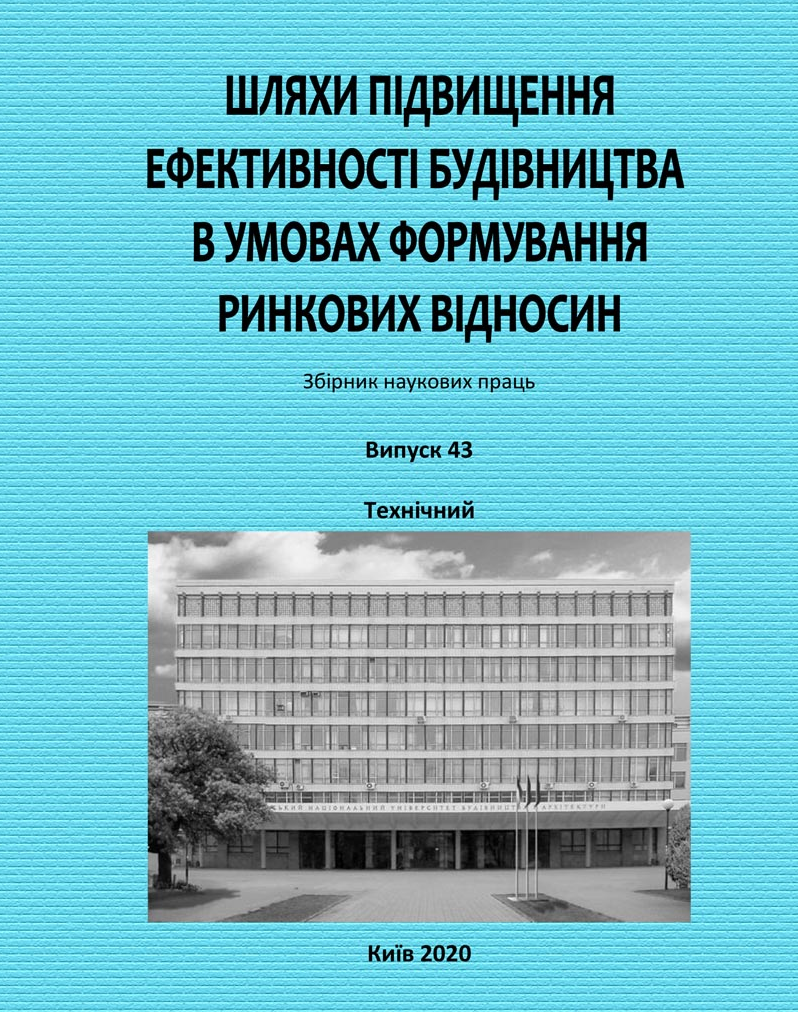Masonry renewal technology
DOI:
https://doi.org/10.32347/2707-501x.2020.43.124-133Keywords:
reconstruction, masonry, amplification, technological processesAbstract
For the construction of residential facilities, even today, they often use a frame-monolithic scheme with floor filling with enclosing structures made of artificial materials - brick, foam concrete, etc. For objects built 25-30 years ago, today there is a whole complex of common problems associated with the destruction front (front) layer of masonry. For this, domestic and foreign developments in the field of inspection and reinforcement of bearing and self-supporting brick structures are analyzed. Among the main criteria for destruction, factors of natural and anthropogenic origin are determined. Climatic conditions - ambient temperature, humidity - significantly affect the choice of basic material, and the current requirements for energy efficiency of building structures significantly affect design decisions for the use of various heaters. At the same time, all architectural and constructive solutions built on modern energy-saving technologies in compliance with current regulations are ineffective in poor quality work. And the desire of the developer to reduce the cost of square meters of housing due to savings on high-quality materials and their required volumes leads over time to emergency situations. In the case of brickwork, most often there are interfloor destruction and loss of elements of the outer surface due to the incorrect (insufficient) number of bonds between the planes. The traditional methods of performing work with reinforcing and restoring masonry are analyzed.The article discusses options for reinforcing multilayer brickwork, which can be applied locally. Formwork fastening elements can be used as reinforcing elements and anchor systems for further reinforcement or finishing. The basic recovery scheme is based on the concept of minimizing costs with a high level of technological processesReferences
DSTU-N B A.2.2-13:2015 (2015), Enerhetychna efektyvnist' budivel' [Energy efficiency of buildings]. Nastanova z provedennia enerhetychnoi otsinky budivel' [Guidelines for energy assessment of buildings].
Orlova N.S., Ulybin O.V., Fedotov S.D. (2018), Vplyv temperaturnykh vplyviv na tsehlianu oblytsiuvannia stin. [Influence of temperature influences on brick facing of walls] Materialy IKh naukovo-praktychnoi konferentsii «Obstezhennia budivel' i sporud: problemy i shliakhy ikh vyrishennia» [Proceedings of the 9th Scientific and Practical Conference "Survey of Buildings and Structures: Problems and Solutions"] (St. Petersburg, October 11-12, 2018) Рр. 160-184.
Kuznetsova H. (2009), Sloystye kladky v karkasno-monolytnom domostroenyy [Layered masonry in frame-monolithic home construction] Tekhnolohyy stroytel'stva. [Construction technologies ], no № 1 (63), рр. 6-22.
Klymenko Ye.V., Bilous I.O. (2009), Eksperymental'ni doslidzhennia roboty tsehlianoi kladky na zriz, po ne perev‘iazanomu shvu [Experimental studies of the work of brickwork on the cut, along the unbound seam], Visnyk Odes'koi derzhavnoi akademii budivnytstva ta arkhitektury [Bulletin of the Odessa State Academy of Civil Engineering and Architecture], Odesa, рр. 171 – 180.
Orlovych R.B., Derkach V.N., Zymyn S.S. (2015), Povrezhdenye kamennoho lytsevoho sloia v zone sopriazhenyia s zhelezobetonnymy perekrytyiamy [Damage to the stone facial layer in the area of conjugation with reinforced concrete overlaps] Ynzhenerno-stroytel'nyj zhurnal [Engineering and construction journal], vol. №8(60), рр. 30–37.
Orlovych R., Mantehatstsa D., Najchuk A., Derkach V. (2010), Sovremennye sposoby remonta y usylenyia kamennykh konstruktsij [Modern methods of repair and reinforcement of stone structures] Arkhytektura, dyzajn, y stroytel'stvo [Architecture, design, and construction], vol. №1(44), рр. 86– 87.
Madan, A. (2013), Seismic vulnerability of masonry infilled reinforced concrete frame structures. International Journal of Safety and Security Engineering, vol. 3, no. 3, рр. 174–183.
R. Pleşu, G. Ţăranu, D. Covatariu, I-D. Grădinariu (2011), Strengthening and rehabilitation conventional methods for masonry structures. Buletinul institutului politehnic din Iaşi, vol. LIV (LVIII), no. 4, Secţia Construcţii. Arhitectură. Рр. 165-176.
Yajun, L., Naiyan, G. (2015), Tests on Seismic Behavior of Pre-cast Shear Walls with Vertical Reinforcements Spliced by Two Different Grout Ways. The Open Civil Engineering Journal, no. 9, рр. 382-387.
Ferretti, E., Pascale G. (2019), Combined Strengthening Techniques to Improve the Out-of-Plane Performance of Masonry Walls. Available: https://www.ncbi.nlm.nih.gov/pmc/articles/PMC6479454/ DOI: 10.3390/ma12071171 [accessed 29 February 2020]. [in English]
Downloads
How to Cite
Issue
Section
License
Copyright (c) 2020 G. Tonkacheev, А. Shpakova, S. Sharapa, I. Glushchenko

This work is licensed under a Creative Commons Attribution 4.0 International License.
Authors who publish with this journal agree to the following terms:
- Authors retain copyright and grant the journal right of first publication with the work simultaneously licensed under a Creative Commons Attribution License that allows others to share the work with an acknowledgement of the work's authorship and initial publication in this journal.
- Authors are able to enter into separate, additional contractual arrangements for the non-exclusive distribution of the journal's published version of the work (e.g., post it to an institutional repository or publish it in a book), with an acknowledgement of its initial publication in this journal.
- Authors are permitted and encouraged to post their work online (e.g., in institutional repositories or on their website) prior to and during the submission process, as it can lead to productive exchanges, as well as earlier and greater citation of published work (See The Effect of Open Access).

